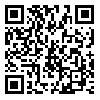Volume 23, Issue 5 (1-2022)
yafte 2022, 23(5): 65-79 |
Back to browse issues page
Download citation:
BibTeX | RIS | EndNote | Medlars | ProCite | Reference Manager | RefWorks
Send citation to:



BibTeX | RIS | EndNote | Medlars | ProCite | Reference Manager | RefWorks
Send citation to:
Zargari S, Bahari A, Goodarzi M T, Mahmoodi M, Valadan R. Genetic Diversity in Key Molecules of Pattern Recognition Receptors (TLR4 and TLR2) in Gastric Cancer. yafte 2022; 23 (5) :65-79
URL: http://yafte.lums.ac.ir/article-1-3468-en.html
URL: http://yafte.lums.ac.ir/article-1-3468-en.html
Research Institute of Modern Biological Techniques, University of Zanjan, Zanjan, Iran
Abstract: (4083 Views)
Background: Gastric cancer (GC) is the second most common malignancy and the leading cause of death in Iran.. According to global statistics, these figures are highly worrying highlighting the importance of studies in this field. Given that the role of chronic inflammation in the development of cancer, especially infection-related cancers, such as GC, has been revealed for many years, evaluating the molecules involved in these processes can be helpful. Toll-like-receptors (TLRs) as the greatest family of receptors for inflammation-associated molecular patterns, and the effect of mutations in TLR2 and TLR4 on the pathology of GC has been identified. Considering the results of previous studies and the major role of TLR2 and TLR4 in inflammatory processes of pre-malignancy, in this study, the mutation in the sequence of these genes and its association with GC have been investigated in both laboratory and bioinformatics stages.
Materials and Methods: In this study, 30 Helicobacter pylori-positive GC samples were collected and after DNA extraction using Sanger sequencing methods, and subsequently, variant pathogenicity predictions, such as SIFT and PolyPhen, mutation pathogenicity was predicted. Following that, PyMOL was applied to model 3D structures of the wild and mutated receptor.
Results: Sanger sequencing data showed a heterozygous mutation in exon 3 of TLR4 c.1061A>G. The modeling crystal structure of the human receptor and LPS complex showed that the variant was far from the TLR4 binding sites with its ligand.
Conclusion: The results of this study indicated that mutations in two important genes of the pattern recognition system in Iranian cancer samples have no functional relevance with these two proteins.
Materials and Methods: In this study, 30 Helicobacter pylori-positive GC samples were collected and after DNA extraction using Sanger sequencing methods, and subsequently, variant pathogenicity predictions, such as SIFT and PolyPhen, mutation pathogenicity was predicted. Following that, PyMOL was applied to model 3D structures of the wild and mutated receptor.
Results: Sanger sequencing data showed a heterozygous mutation in exon 3 of TLR4 c.1061A>G. The modeling crystal structure of the human receptor and LPS complex showed that the variant was far from the TLR4 binding sites with its ligand.
Conclusion: The results of this study indicated that mutations in two important genes of the pattern recognition system in Iranian cancer samples have no functional relevance with these two proteins.
Type of Study: Original Research |
Subject:
عفونی
Received: 2021/12/26 | Accepted: 2022/01/25 | Published: 2022/03/6
Received: 2021/12/26 | Accepted: 2022/01/25 | Published: 2022/03/6
Send email to the article author
| Rights and permissions | |
 |
This work is licensed under a Creative Commons Attribution-NonCommercial 4.0 International License. |







